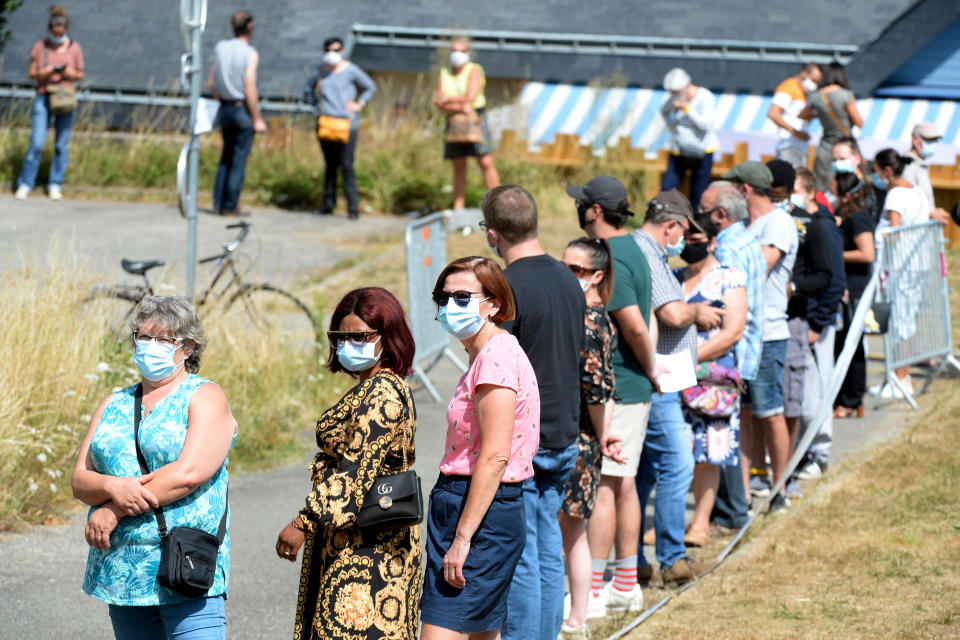Trump says U.S. is 'creating trouble' by mass testing for COVID-19. Experts disagree.
LONDON — Ah, no.
That’s the response from epidemiologists after President Donald Trump said that the United States has “the best testing in the world” for COVID-19, and suggested that Europe’s relatively low numbers are because its countries “don’t test.”
“On the specific question of whether we’ve done so much testing that that’s why we have cases, it’s quite the opposite,” Marc Lipsitch, an epidemiologist at the Harvard T.H. Chan School of Public Health, told NBC News on a video call late Sunday. “We’re doing more testing now because we have so many cases that we can’t keep up.”
In a freewheeling interview with Fox News' Chris Wallace that aired Sunday, Trump repeated his long-standing frustration with the higher levels of testing in the U.S., saying, "In a way, we're creating trouble."
"Well, cases are up — many of those cases shouldn't even be cases," he said.
The U.S., which currently has some of the highest case numbers in the world, has had more than 141,000 deaths from the coronavirus, according to NBC News' tracker.
Trump also suggested that some other countries have had less severe outbreaks than the U.S. precisely because they "don't test."
Lipsitch, who runs Harvard’s Center for Communicable Disease Dynamics, one of two centers of excellence that gets funding from a National Institutes of Health study on infectious disease models, disagreed with the president.
“If you look at the ratio of number of tests we've done to the number of confirmed cases, it's not very good, it's not the best on earth by far,” he said. “When you have more cases, you have to do more testing. It's not just that you find more cases with more tests.”

The United States has carried out more than 47 million tests since the start of the pandemic, according to data published by the Centers for Disease Control and Prevention. When controlled for overall population size, the number of daily tests carried out in the U.S. per 1,000 people over a seven-day rolling average is 2.82, according to a composite of state and CDC data.
Both those numbers are higher than most other countries, and Trump told Wallace that, “Cases are up because we have the best testing in the world and we have the most testing.”
The metric to watch
Several experts said that to suggest a causal link between the frequency of tests and the total number of positive COVID-19 cases was wrong.
A far more useful metric, according to epidemiologists, is the “positivity rate” that measures the number of positive cases of COVID-19 that turn up among the tests that are performed each day.
“The rate is important because that gives us some sense of the burden in the overall population when we look at the positivity,” said Jeffrey Klausner, professor of epidemiology and infectious diseases at the UCLA Fielding School of Public Health and at the David Geffen School of Medicine.
Testing numbers are only useful if they lead to a reduction in viral spread, he said.
“Every positive test has to result in isolation of that case, and then contact notification of any contacts that have been associated with that case,” Klausner said. “My concern is while we're doing a lot of testing, we're finding a lot of cases, those aren't having the public health impact that they should.”
The U.S. positivity rate currently stands at 9 percent, according to the CDC — comparable to rates in Pakistan, Iran, Kenya and Zimbabwe.

And while that rate varies significantly between different states, according to the Covid Tracking Project, 34 of the 50 states as of Sunday had a positivity rate higher than 5 percent — a threshold above which the World Health Organization suggests policymakers should not relax social distancing measures.
In European nations that have been through severe outbreaks, that number is currently much lower: 1.4 percent in Spain, 1.1 percent in France, 0.8 percent in Italy, 0.6 percent in Germany and 0.5 percent in the United Kingdom.
“The clue to the entire debate: It doesn't matter how many tests you make, but how many returned positive,” said Dirk Brockmann, a physicist at Humboldt University in Berlin who is currently working full time on pandemic modeling at the Robert Koch Institute, Germany’s main center for the identification, surveillance and prevention of infectious diseases.
Download the NBC News app for latest updates on the coronavirus outbreak.
He said the situation in Germany now is “promising” thanks to the widespread adoption of social distancing measures, and the success of those efforts had saved the country from the kind of trouble seen elsewhere, including the U.S.
The rate of testing in the U.S. might be three times higher than in Germany, he acknowledged, but that does not provide any explanation for why the curve is steepening again in the U.S.
One other significant obstacle that prevents the high U.S. testing numbers from translating to successful containment is speed — or the lack of it when it comes to results.
Americans in many states are waiting hours to be tested, then up to a week or longer for their results, meaning the snapshot of the pandemic provided by those results is quickly outdated.
Meanwhile in other developed countries like the United Kingdom, Germany and Russia, tests are readily available, with results typically available within 24 hours.
“We're not keeping up with the tests,” Harvard’s Lipsitch said. “Everybody I talked to has a hard time getting a result within a reasonable period of time.”

